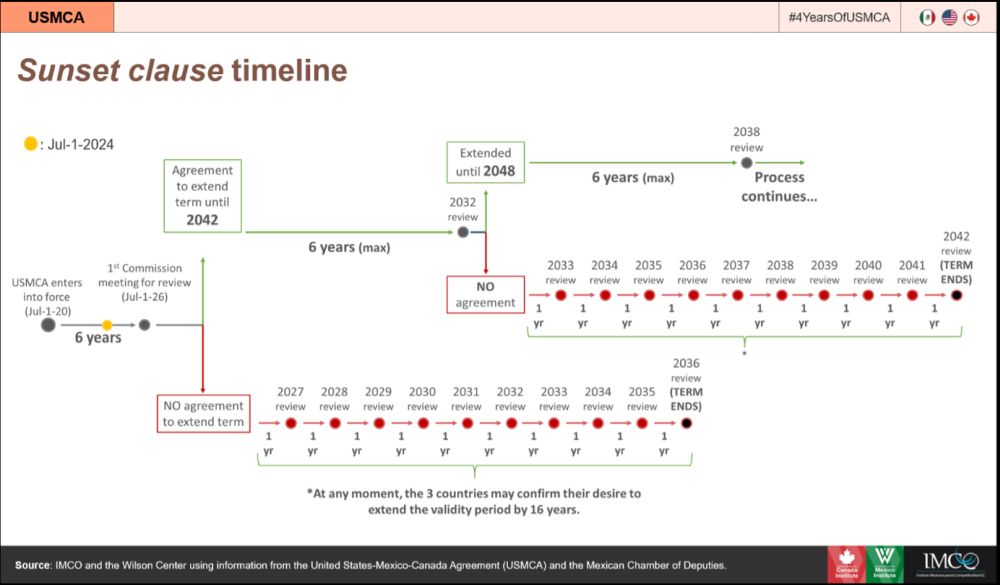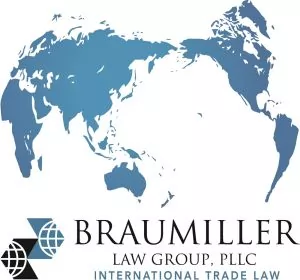This is the first of a three-part series about the USMCA joint review process, focusing on China, Mexico, and competing visions of a "worker-centered" trade policy. Part one introduces the USMCA joint review process and explores how US trade policy would likely operate during Trump's second term. Part two outlines some of the major trade issues that will be on the table during joint review, focusing on the Mexico-US relationship, and anticipates Harris's likely approach to trade policy. Part three offers a critique of the worker-centered trade policy developed under the Biden administration, presents an alternative, and suggests new avenues for multi-stakeholder participation that Harris's approach might create.
Introduction
The next White House occupant will have the unprecedented opportunity to decide the United States-Mexico-Canada Agreement's (USMCA's) fate. USMCA contains a sunset clause, Article 34.7, which terminates the Agreement in 2036 unless the parties agree to extend it through a "joint review" process set to begin on July 1, 2026. Readers facing more immediate challenges in 2024 might question the urgency of a decision that lies two years in the future, under an undetermined administration, and whose direct legal effect is delayed for ten years after that. But the USMCA's implementing legislation, 19 USC § 4611, requires the President to "consult with the appropriate congressional committees and stakeholders", as well as relevant executive branch officials, and to "provide opportunity for the presentation of views in relation to the operation of the USMCA, including a public hearing" at least 270 days before each joint review. To readers with a stake in North American trade—that is, at minimum, all North Americans: the time to strategize your participation is now.
The sunset clause was controversial, not least because it introduced little more to the Agreement than the fretful insistence of a doomsday clock. As former President Trump's Trade Representative (USTR) Robert Lighthizer has noted, "[m]ost trade agreements, for reasons that don't make any sense to me, are eternal... this one is temporal, although it's complicated how it works."1 The Agreement is initially set to expire 16 years from the date it enters into force. Every six years, the Free Trade Commission (or FTC, a group of minister-level government representatives from each party2) conducts a joint review during which they decide whether or not to extend the Agreement by six years. If they extend the Agreement, then they can simply wait until the next joint review; otherwise, they must conduct annual reviews until the original expiration date. At any time in between, they may change their minds and extend the Agreement. The FTC may also, of course, meet between joint reviews and establish, dissolve, or otherwise collaborate with committees, working groups, and other subsidiary bodies to aid its decision-making. In May 2024, for example, the FTC held its fourth meeting, where it "took note of readouts from the Working Group for Cooperation on Agricultural Biotechnology and the Committees on Textiles, Technical Barriers to Trade, Good Regulatory Practices, State-Owned Enterprises and Designated Monopolies, and Small and Medium-Sized Enterprises."3 Aside from consultation with and reporting to congressional committees, USMCA does not reserve any particular authority for Congress in the joint review process, so from a legal perspective the outcome depends on the executive branch—Congress's role is essentially political.

What readers should take most interest in is the process, specifically the approach that each prospective administration is likely to employ in a joint review, and the opportunities that each approach is likely to open to stakeholders to influence decision-making. Some predict that neither Trump nor Biden (or likely Harris) would extend USMCA in 2024.4 But like choices, in this case, will not lead to like results. When it comes to addressing some of the toughest challenges recognized on both sides of the political aisle, the two administrations' approaches are rooted in fundamentally incompatible philosophical principles and priorities. Possibilities for stakeholder engagement, and outcomes for stakeholders, vary accordingly.
Trump and "Lighthizerism"
Trump has a clear vision for trade policy: wield it like a club and beat negotiating partners with it until they give him what he wants. In his second term, Trump has proposed a "ring around the country," meaning a 60% tariff on all goods from China and a 10% tariff on all goods from all other countries (in addition to the Section 201, 232, and 301 tariffs his last administration imposed, as well as existing antidumping and countervailing measures).5 The architect of Trump's trade framework was former USTR Robert Lighthizer. The two are reportedly still close, and Lighthizer would likely play a prominent role in Trump's next administration, perhaps as Treasury secretary.6 For that reason, readers will benefit from an understanding of Lighthizer's perspective on trade.
During Trump's first term, international political economy scholar Quinn Slobodian observed that "Lighthizerism departs from standard free trade philosophy [...] in its commitment to using an openly politicized arsenal of tools" to improve the US's trade deficit; in its scorn for constructivist, multilateral approaches in favor of transactional, bilateral ones; and in its embrace of unilateral executive action to "[unsettle] existing arrangements and [push] partners to the negotiating table."7 Lighthizer began his trade career as a deputy US trade representative in the 1980s, when the American factory worker's bogeyman was a Japanese manager, not a Chinese bureaucrat,8 and the Reagan administration was combatting global industrial competition by pioneering the use of "aggressive unilateralism" in the form of Section 301 tariffs.9 In Slobodian's view, Lighthizer hardened his philosophy in the crucible of 1980's trade conflicts, which Lighthizer believes the "icon of modern conservatism, Ronald Reagan, [won by imposing] quotas on imported steel, protect[ing] Harley-Davidson from Japanese competition, restrain[ing] imports of semiconductors and automobiles, and [taking] myriad similar steps to keep American industry strong."10
Citing congressional testimony by Lighthizer in 2018, Slobodian illustrates how Lighthizerism has adapted to a world where China is the US's new super-competitor by "taking a page from the playbook of what [he] sees as [the US's] main adversary: Chinese state capitalism." After reflecting on a Congress member's question about whether the US, with all of its democratic restraints, can rely on tariffs to sustain a long-term competition with an unrestrained non-democracy like China, Lighthizer responded: "[The Chinese] do take a longer view, which by the way, I think is the right view. To the extent we can, we ought to be taking it."11 Lighthizer elaborated more recently during an interview he gave at Harvard, lauding China's use of a "mercantilist economic policy" to create surpluses, which in his judgment "they're smart to do."12 While more analysis would be necessary to draw clear parallels between Lighthizerism's role in a Trump administration's overall industrial policy and Chinese-style state capitalism, the strategy that Lighthizer lifts from China's playbook is to make full use of the concentrated power of the executive branch. Imposing tariffs by unilateral executive action—as Trump did with Section 301, for example—is Lighthizer's way of enacting a mercantilist policy, as he believes China can, without interference from a Congress whose constituents are broadly supportive of free trade. Under Lighthizerism, in Slobodian's framing, democratic accountability is "an unfair disadvantage that the adversary does not share."13
To be sure, a democratic administration would employ the same tools—after all, it would face the same global challenges. Biden has not lowered the Trump-era tariffs, and in fact has expanded them in product categories such as solar panels, electric vehicles, batteries, steel and aluminum, and some medical products. And Biden USTR Katherine Tai's view on the proper goals of trade policy coincides with Lighthizer's in certain respects, at least rhetorically, in particular with regard to labor. In Lighthizer's words: "We need a worker-focused trade policy not a corporate, price-centered one."14 During her time as USTR, Tai has famously pioneered a similar-sounding "worker-centered" trade policy. But for Tai, this policy involves strategies such as using USMCA's Rapid Response Mechanism (RRM), as well as multi-stakeholder negotiations, to improve labor standards in Mexico so that American employers can less easily use the threat of offshoring against organized American workers.15 Lighthizer's vision for a worker-centered trade policy, insofar as he has articulated one, is fundamentally different.
Lighthizer's worker-centered policy appears to revolve around the traditional tool of granting or withholding market access, largely by adjusting tariff rates through executive action, and aims primarily to "eliminate the trade deficits that are bleeding our country to death and achieve balanced trade."16 For Lighthizer, tariffs are a worker-centered trade policy. They are the persuasive power that a Trump FTC representative would open-carry at every joint review. They are the tools at the disposal of working groups, committees, and any other stakeholder who wishes to have a voice in trade negotiations. Readers with a stake in trade policy, including the upcoming USMCA joint review, should think carefully about how far these tools can take them towards reaching their own goals (especially considering that they are readily available to any administration), about what opportunities they do or do not create, and about who bears their costs and benefits. More on that next time.
...
The next part in this series outlines some of the major trade issues that will be on the table during joint review, focusing on the Mexico-US relationship, and anticipates Harris's likely approach to trade policy.
Read more articles by these authors: https://www.braumillerlaw.com/author/adriennebraumiller/
Read more articles by these authors: https://www.braumillerconsulting.com/author/gavin-andersen/
Footnotes
1. US Trade Representative Robert Lighthizer. Quote from: US Congress. Hearing of the Ways and Means Committee. The 2019 Trade Agenda Speech transcript.. June 19, 2019. https://www.youtube.com/watch?v=HgEOQJydZ_o.
2. In 2024, at the time of writing, the FTC members are USTR Katherine Tai; Canadian Minister of Export Promotion, International Trade and Economic Development Mary Ng; and Mexican Secretary of Economy Raquel Buenrostro.
3. Office of the United States Trade Representative. United States, Canada, and Mexico Joint Statement of the Fourth Meeting of the USMCA//CUSMA//T-MEC Free Trade Commission. May 23, 2024. https://ustr.gov/about-us/policy-offices/press-office/press-releases/2024/may/united-states-canada-and-mexico-joint-statement-fourth-meeting-usmcacusmat-mec-free-trade-commission
4. Lee, Mara. USMCA Expert: Expect US to Say No to 16-Year Renewal in 2026. International Trade Today. July 17, 2024. https://internationaltradetoday.com/news/2024/07/17/usmca-expert-expect-us-to-say-no-to-16year-renewal-in-2026-2407170048
5. Chapman, Michael. Trump's Tariff Plan Will Raise Prices for Consumers, Just as Bastiat Warned 170 Years Ago. Cato Institute. July 15, 2024. https://www.cato.org/blog/trumps-tariff-plan-will-raise-prices-consumers-just-bastiat-warned-170-years-ago
6. Alden, Edward. The Man Who Would Help Trump Upend the Global Economy. Foreign Policy. May 18, 2024. https://foreignpolicy.com/2024/05/18/robert-lighthizer-trump-election-trade-tariffs-treasury-secretary/
7. Slobodian, Quinn. You Live in Robert Lighthizer's World Now. Foreign Policy. August 6, 2018. https://foreignpolicy.com/2018/08/06/you-live-in-robert-lighthizers-world-now-trump-trade/
8. See, for example, the 1986 film Gung Ho, starring Michael Keaton.
9. See Bhagwati, Jagdish and Hugh T. Patrick. Aggressive Unilateralism: America's 301 Trade Policy and the World Trading System. University of Michigan Press, 1991.
10. Lighthizer, Robert. LIGHTHIZER: Donald Trump is no liberal on trade. The Washington Times. May 9, 2011. https://www.washingtontimes.com/news/2011/may/9/donald-trump-is-no-liberal-on-trade/
11. Slobodian, supra.
12. The Policymakers Series – Ambassador Robert E. Lighthizer with Mark Wu Speech transcript.. Fairbank Center for Chinese Studies | Harvard University. February 15, 2024. https://www.youtube.com/watch?v=Tu6vxZlCC2g
13. Slobodian, supra.
14. The New American System: Trade for workers in the 21st Century Speech transcript.. Intercollegiate Studies Institute. August 30, 2022. https://www.youtube.com/watch?v=PmjB9w1VC-A
15. US Trade Representative Katherine Tai. US Congress. Hearing of the Ways and Means Committee Republicans. Hearing on the Biden Administration's 2024 Trade Agenda with U.S. Trade Representative Katherine Tai Speech transcript.. April 16, 2024. https://www.youtube.com/watch?v=ZeDfYL3Dq0Q
16. Robert Lighthizer – The New American System: Trade for workers in the 21st Century Speech transcript.. Intercollegiate Studies Institute. August 30, 2022. https://www.youtube.com/watch?v=PmjB9w1VC-A
Check out our new Digital Magazine Get the inside scoop on the Braumiller Law Group & Braumiller Consulting Group "peeps." Expertise in International Trade Compliance.
The content of this article is intended to provide a general guide to the subject matter. Specialist advice should be sought about your specific circumstances.



